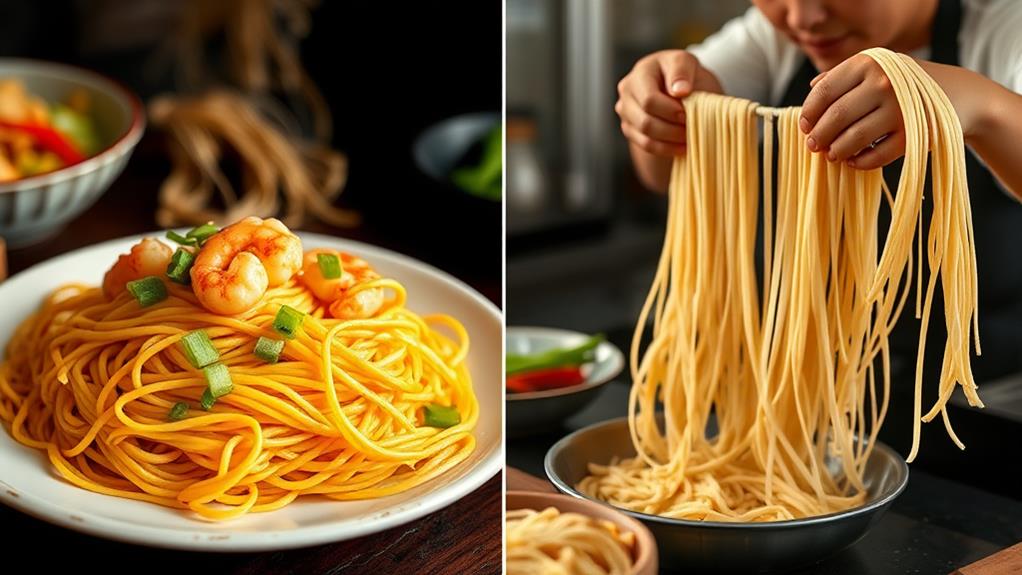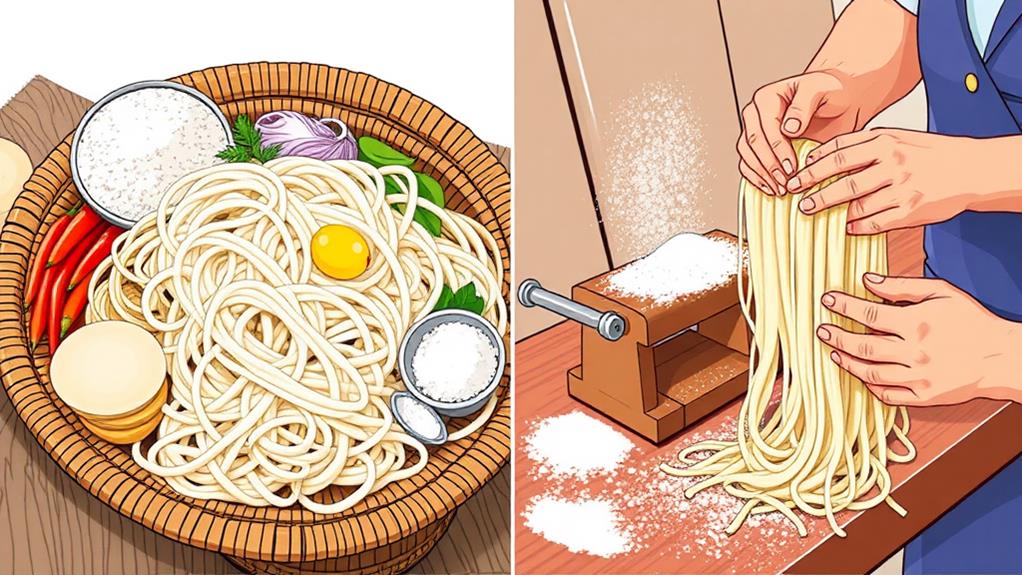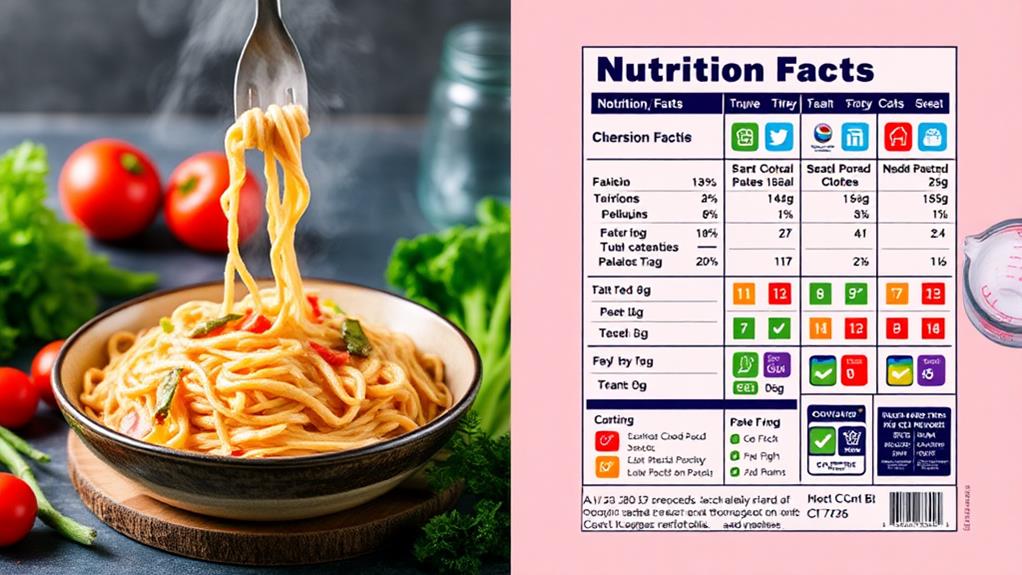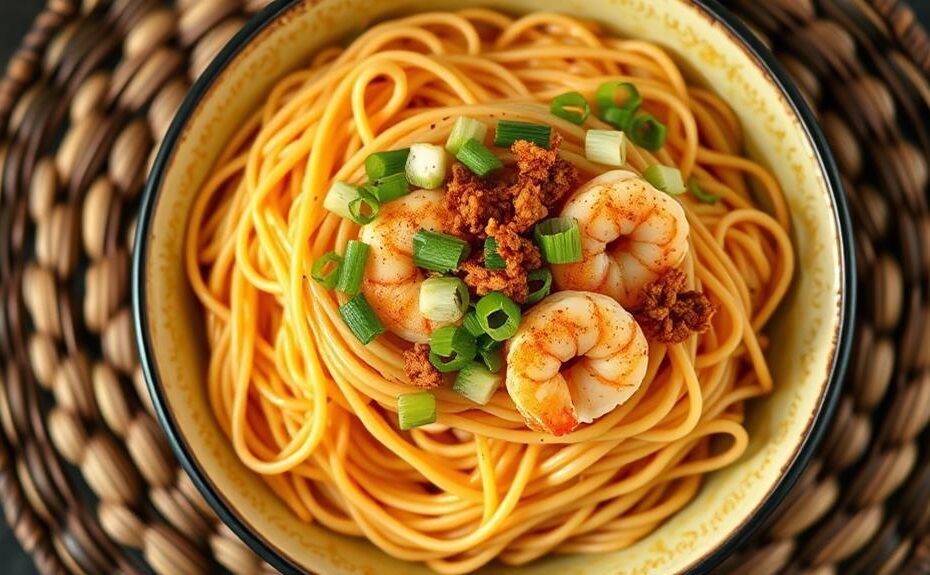Palabok noodles are a traditional Filipino dish made from rice flour, making them gluten-free.
These noodles are characterized by a rich, savory sauce, typically made from shrimp or pork. The sauce is a crucial component of Palabok, and its preparation involves sautéing garlic and onions, adding shrimp stock, ground pork, and seasonings.
To cook Palabok noodles, they need to be soaked in warm water, then briefly boiled until tender.
After cooking the noodles, they are combined with the savory sauce to create the final dish.
Understanding the process of making Palabok is key to perfecting its flavors and textures.
Understanding Pancit Palabok

Understanding Pancit Palabok Noodles
Traditional Pancit Palabok noodles are made from thin rice noodles called bihon. To achieve the right texture, these noodles are soaked in water before cooking. They're then boiled until just tender, ensuring they remain firm and can absorb the palabok sauce effectively.
The Palabok Sauce
The palabok sauce is a key component of the dish, characterized by its bright orange hue due to the use of annatto powder mixed with shrimp and pork broth. This flavorful sauce brings the dish together, complemented by various toppings.
Toppings and Presentation
Toppings like hard-boiled eggs, chicharrón (crispy pork skin), and green onions enhance both the flavor and presentation of Pancit Palabok. These toppings add depth and complexity to the dish, making it both familiar and exciting.
Appreciating the Dish
By understanding the individual components of Pancit Palabok, you'll gain a deeper appreciation for the attention to detail that goes into creating each element.
This appreciation will allow you to fully enjoy the complexity and nuance of this beloved Filipino noodle dish.
History and Cultural Significance
Palabok Noodles' Cultural Significance in the Philippines
Introduction to Palabok Noodles
Palabok noodles, also known as bihon, originated from Chinese culinary traditions and were introduced to the Philippines by migrants. This introduction forever changed the country's culinary landscape.
Cultural Value of Pancit Palabok
Pancit Palabok, a staple in Filipino cuisine, holds significant cultural value. The term "Pancit" comes from the Hokkien phrase "pian e sit," meaning "conveniently cooked dish," highlighting the ease of preparation.
Traditional Significance
Traditionally, Pancit Palabok is served during celebrations, symbolizing hospitality and family bonding. The dish's bright orange sauce, made with annatto, enriches the noodles both visually and flavor-wise, serving as a representation of the vibrant Filipino culinary heritage.
Evolution into Comfort Food
Over generations, Pancit Palabok has evolved into a beloved comfort food, often featured in Filipino restaurants worldwide. This has preserved the cultural connection among Filipinos, both locally and abroad.
Reflection of Cultural Heritage
As you explore the world of Palabok noodles, you'll understand the significance it holds in Filipino gatherings, reflecting the country's rich cultural heritage.
Ingredients and Preparation Methods

Preparing Traditional Palabok Noodles
To prepare traditional bihon noodles, soak them in warm water for about 15 minutes, then boil them briefly until they're firm yet tender.
Overcooking can make them mushy, so be careful.
Crafting the Signature Sauce
The sauce for Pancit Palabok requires shrimp stock, ground pork, and annatto powder, which adds flavor and that signature orange color.
Shrimp heads are essential for stock, while garlic and onion provide aromatics, and fish sauce (patis) adds umami flavor.
Assembling the Dish
For a richer taste, toss the cooked noodles with the sauce immediately to allow them to absorb the flavors.
Types of Noodles Used
Noodle Choice Matters in Pancit Palabok
The type of noodles used in Pancit Palabok significantly impacts the dish's overall flavor and texture. Traditionally, bihon noodles are used in Pancit Palabok, which are thin rice noodles known for their light texture and ability to absorb flavors from the sauce. However, variations may use thicker cornstarch noodles, like Pancit Luglug, or thick, tubular rice noodles, like Pancit Malabon.
Noodle Characteristics:
| Type of Noodle | Characteristics |
|---|---|
| Bihon Noodles | Thin, light, absorbs flavors well |
| Pancit Luglug Noodles | Thicker, cornstarch-based, boiled |
| Pancit Malabon Noodles | Thick, tubular, holds up to heavy sauce and toppings |
Authenticity and Cooking Tips:
To ensure authenticity, purchase noodles specifically labeled as bihon or palabok noodles from Asian grocery stores. When cooking, soak bihon noodles in water before boiling to achieve the right texture, allowing them to remain firm and not mushy when combined with the sauce. This attention to detail will make a significant difference in your Pancit Palabok's overall quality.
Sauce and Flavor Enhancements

Crafting the perfect Palabok sauce requires attention to detail and a deliberate process.
To create a rich and savory base, combine shrimp stock and pork broth. This mixture serves as the foundation of the dish's flavor profile.
Annatto powder is added to give the sauce its signature vibrant orange color and a subtle earthy flavor.
To enhance the sauce's flavor, crush shrimp heads and simmer them with other ingredients to release natural juices, resulting in a more complex taste.
A splash of fish sauce (patis) not only seasons the sauce but also contributes a distinct umami flavor, elevating the dish's overall profile.
To achieve the desired consistency, thicken the sauce with a cornstarch slurry, ensuring it effectively coats the noodles.
Cooking Tips and Variations
Achieving the Perfect Texture
To cook Palabok noodles with precision, soak the thin rice noodles in water for about 15 minutes before boiling to maintain their firmness.
Elevating the Flavor
A rich shrimp stock adds depth to the dish. Make the stock by boiling fresh shrimp shells and heads.
Then, sauté garlic and onions until fragrant before adding the broth and shrimp to create a flavorful base for the sauce.
For a thicker sauce, add a cornstarch slurry to the simmering broth, allowing it to thicken before mixing in the noodles and toppings.
Customizing with Toppings
To create personalized versions of Palabok, experiment with various toppings.
Try adding fried tofu, squid, or mussels alongside traditional shrimp and chicharrón.
These combinations will help you master the art of making Palabok noodles with a perfect balance of texture and flavor.
Nutritional Information and Serving

Nutritional Information and Serving Size
A serving of Pancit Palabok contains approximately 564 kcal, making it a substantial meal option. This serving provides 74g of carbohydrates from the rice noodles, 32g of protein from the shrimp and pork, and 14g of fat, with 4g being saturated fat. This moderate fat content is a critical consideration for a balanced diet.
Pancit Palabok is a nutrient-rich dish, providing essential vitamins and minerals. A serving contains 189 IU of Vitamin A and 187mg of Calcium, contributing to its nutritional value.
However, the sodium content is relatively high at 1376mg per serving, which is crucial to consider for those monitoring their salt intake. To maintain a balanced diet, it's essential to be mindful of the portion size when serving Pancit Palabok.
Can I Make Palabok Noodles Without All the Required Ingredients?
Yes, you can make palabok noodles without all the required ingredients for palabok noodles. You can use substitutes for some ingredients such as using regular noodles instead of rice noodles and improvising the sauce with available ingredients. It may not be authentic, but it can still be delicious.
Recipe References and Accessibility
Reliable Recipe References for Pancit Palabok
When preparing Pancit Palabok, home cooks can turn to trusted recipe references for guidance.
Cookbooks like "Memories of Philippine Kitchens" and "The New Filipino Kitchen" offer traditional and modern approaches to this dish.
Online platforms like PanlasangPinoy.com also provide accessible recipes and a community for sharing experiences and variations of Pancit Palabok.
Sourcing High-Quality Ingredients
To make Pancit Palabok, you'll need high-quality rice noodles, specifically bihon or palabok noodles.
These can be found in Filipino and Asian grocery stores.
Recommended brands include:
- Pamana for its optimal texture and flavor
- KA-ME for its consistent quality
- Local grocery stores, which increasingly carry the necessary ingredients, making it easier to recreate this dish.
Frequently Asked Questions
What Are Palabok Noodles Made Of?
Palabok noodles are traditionally made from bihon, a type of thin rice noodle. These noodles are known for their delicate texture and ability to absorb sauces well. They can be found at Filipino and Asian grocery stores, with brands like Pamana recommended for quality.
In some variations, thicker cornstarch noodles, like those used in Pancit Luglug, may be used instead. These noodles require a different cooking method.
What Is Palabok Mix Made Of?
A palabok mix typically contains a blend of shrimp broth, annatto powder, and seasonings.
Annatto powder gives the mix its signature orange hue, while seasonings like garlic and fish sauce add flavor.
Dehydrated shrimp or shrimp cubes are often added to boost the seafood flavor.
Some mixes may also include cornstarch as a thickening agent.
Ingredients can vary by brand, and some may incorporate extra spices or flavor enhancers to cater to different tastes.
What's the Difference Between Pancit and Palabok?
Pancit is an umbrella term in Filipino cuisine that encompasses various noodle dishes. These dishes have diverse histories, regional twists, and cooking techniques. For instance, some pancit dishes are made with rice flour noodles, while others use egg noodles or mung bean noodles.
Palabok, on the other hand, is a specific type of pancit. It's characterized by its rich, yellow-orange sauce and thin rice noodles. The flavor profile of palabok is distinct from other pancit dishes, with a hearty, savory sauce that sets it apart.
The flavor profiles of pancit and palabok differ. Pancit often features lighter, stir-fried ingredients, while palabok boasts a rich, savory sauce.
This difference in flavor profile also affects the way they're served and their cultural significance.
What Is the Difference Between Pancit Luglug and Palabok?
Pancit Luglug and Palabok differ in their noodle types and textures. Pancit Luglug features thicker cornstarch noodles, whereas Palabok uses thin bihon rice noodles. This distinction in noodle type affects the overall texture of the dishes.
The flavor profiles of Pancit Luglug and Palabok are distinct due to their traditional ingredients. Pancit Luglug is typically made with shrimp and pork stock, which creates a unique flavor. The ingredients used in Palabok vary, resulting in a different taste.
Regional differences also contribute to the distinction between Pancit Luglug and Palabok. Pancit Luglug has a simpler sauce and varied toppings, whereas Palabok has a more complex sauce and fixed toppings. The way the noodles are prepared, such as boiling and soaking, also differs between the two dishes.
The cultural significance and popular garnishes of Pancit Luglug and Palabok set them apart. For example, Pancit Luglug is often garnished with chicharrón and hard-boiled eggs, which isn't typically seen in Palabok.
